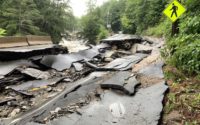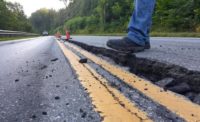About one month since Vermont was hit with a historic flood event that caused some of the worst destruction on record and two deaths, contractors are making progress on repairs.
In another positive step, the U.S. Dept. of Transportation Federal Highway Administration announced on Aug. 11 the immediate availability of $10 million in “quick release” emergency relief funds.
The aid is an initial installment to the Vermont Agency of Transportation (VTrans) to offset infrastructure repair costs.
“This emergency funding will help the people of Vermont repair critical infrastructure as we continue working to support Vermonters in their efforts to recover and rebuild,” U.S. Transportation Secretary Pete Buttigieg said in a press release announcing the funding.
FHWA said the funding will be used help with “clearing mud and rockslides from the roadway; opening plugged culverts; repairing culverts and eroded shoulders; clearing material deposited by floodwaters onto structures; making repairs to damaged roadways and structures; and repairing and replacing guardrails.”
The initial funds pale in comparison to early estimates of known costs for infrastructure damage. A spokesman for VTrans estimated it at $131 million, including $71 million in damage to state and local roads and $10 to $20 million to federal highways.
“But that [figure] is going to go much higher with public infrastructure and private property damage,” the spokesman says.

The team employed two butt fusion machines that in a 40-minute process cuts both ends of the HDPE pipe, then heats them up to create a weld as strong as the rest of the pipe.
Courtesty of Engineers Construction
The funding comes after Vermont’s three-member congressional delegation pushed for federal aid in an Aug. 9 letter to President Joe Biden.
The letter outlines the catastrophic impact of flash flood events that began on July 7, including the Johnson, Vt., wastewater treatment facility that was "completely destroyed and will likely cost upward of $10 million to replace,” it said.
Lawmakers also noted damage to dams across the state, adding that state inspectors classified five dams as high hazard and 22 as significant hazard.

Burlington Dept of Public Works temporary on-ground wastewater bypass pipe required stringing 50-ft-long pieces of pipe across the city, across the Greenbelt, across people’s lawns and under driveways.
Courtesy of Engineers Construction Inc.
Road to Repair
More than143 state roads have reopened since the July storm, including Vt. 110, which sustained damage at four sites. Four state roads remained fully closed and seven roads remained partially open as of an Aug. 8 press briefing with Gov. Phil Scott (D) and state Transportation Secretary Joe Flynn.
“Those sites have all been repaired with temporary bridges,” said Flynn, noting that one portion of Vt-110 in Eastberry is closed near a VTrans construction project that began before the storm.

Workers replacing failed culvert in Hardwick
Courtesy of J.P. Sicard
The agency is currently working with towns in 28 rural areas and 39 contractors on agency projects. In the past month, VTrans has identified 1,102 damaged sites on its road and bridge network and 826 impacted culverts, Flynn said.
The agency has performed 142,000 linear feet of ditch work and 20 miles of new paving. So far it has used 366,000 lb of rock, installed 7,000 ft of guardrail and worked on 236 slopes or slides.
Of the 12 active construction sites that were damaged, 11 have been recovered and “we are preparing to resume [work],” Flynn said. From Barre up to Websterville, 11.17 miles of active railroad remain closed.

Burlington Dept. of Public Works introduced non-toxic dye into their broken sewer line Aug. 1 to help determine where the break is located as the water is currently too turbid for an in-river inspection.
Courtesy of UVM Spatial Analysis Lab drone footage
Vtrans has also reopened more than half of the newly completed 93-mile Lamoille Valley Rail Trail in northeastern Vermont, with plans to reopen additional sections in the coming months. Of the 103 damaged and closed rail trail sites, 16 will require civil engineering to complete work. Flynn says repairs are not likely to be completed before early 2024.

View of approach slabs undermined on each side of the Rt. 16 Bridge, Hardwick
Courtesy of J.P. Sicard
Emergency repairs
Meanwhile some contractors are finishing emergency repairs amid the challenges of unsettled weather.
Following a July 12 sewer pipe failure that leaked an estimated 3 million gallons of untreated sewage into the Winooski River in Burlington, Engineers Construction Inc. of Williston, Vt.—which has an on-call service contract with the city—installed a mile-long, temporary bypass in four-and-a-half days. The temporary fix and other mitigation efforts cost the city $800,000, according to a spokesman.
The city initially wanted to develop a long-term repair involving underground directional drilling. City officials also wanted to find a way to return the sewer to their gravity system “to stop allowing the sewer force main from flowing into the Winooski River, which then discharges directly to Lake Champlain,” says Ben Heath, civil construction manager at Engineers Construction.

Hardwick Bridge Failure on the 93-mile Lamoille Rail Trail in central Vermont
Courtesy of Vermont Agency of Transportation
While reviewing the city’s original plan—which had an alignment to send the force main to the existing gravity system at the top of the hill above the North plant—Engineers Construction and the city had concerns this would “cause basements to flood with sewerage” due to the anticipated “large daily flow of more than 1 million gallons per day” into the existing system, which was “already near capacity,” Heath says.
Instead, the team opted “to install a temporary pump station on the southern side of the river, to intersect it on the upstream side where it crosses the Winooski River… and then a mile-long temporary forcemain pipe to the [Winooski] wastewater treatment plant where this system is discharged ....,” Heath says.
That involved installing the pipe largely on the surface, with parts and pieces that were "the easiest to procure” for a temporary fix, he says.
On Aug. 4, the city released a request for qualifications for an engineering firm to design permanent and resilient repair options.
In Hardwick, one of the worst-hit towns in northeast Vermont, contractor J.P. Sicard Inc. responded to a call from VTrans to help repair areas of Vermont Route 15. “The highway was washed out pretty close to the centerline for a few hundred feet,” says Jason Sicard, firm president.

Wolcott Bridge is on the final six-mile section of the 93-mile Lamoille Rail Trail from Hardwick to Wolcott Village, completed in February in central Vermont.
Courtesy of Vermont Agency of Transportation
As crews began repairs, other landslides developed when the pavement buckled under the weight of the heavy construction vehicles, including Caterpillar excavators, a D6 bulldozer, a compacter and a butt loader.
“There was quite a bit of iron there for the small site because so much of the depth was gone,” Sicard says.
The setback forced the team to close the road for an additional day before it could mitigate the damage and stabilize the slide with stone. "Once that was accomplished, it was safe enough to reopen the route for one-way traffic with portable automated streetlights," he says.
The road opened to two-way traffic on Aug. 4.
Gov. Scott said that in the next month the state will finish work on debris removal and infrastructure repairs. "By fall, the conversation will transition to mitigation, recovery and revitalization,” he said.
.jpg?1691778008)




Post a comment to this article
Report Abusive Comment